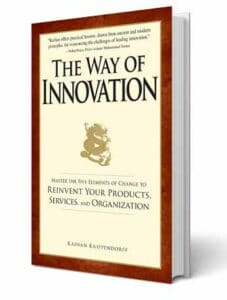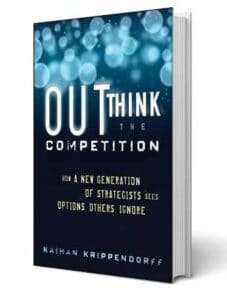Here is Your Five-Step Playbook to Future-proof Your Business
Most companies, when designing their strategy, default to the obvious solutions. They take what has worked in the past, rinse it, and expect those the same principles to hold true in the future. This results in uninventive strategies that, while they may be successful in the short-term, decay in effectiveness year after year until an unexpected disruption throws them entirely off course. Businesses that are not used to incorporating innovation into their strategic planning will be left wondering what hit them and how to pivot.
The uncertainty of the past year has rendered this method of planning impossible to continue. In particular, the financial services sector, known for being slow to innovate, weighed down by tradition and heavy regulation, has seen the abrupt impact of immediate and unanticipated change. Adoption of new technologies and sudden changes in client behavior, accelerated by Covid-19 lockdowns, has propelled industry trends that are changing the way customers interact with their banks.
Five trends are shaping the future of financial services. The changes that are altering the industry are neither temporary nor really new. They were already taking root before COVID and were accelerated, not caused, by the pandemic. And as such, we are not going back to business as usual. We have instead taken a leap forward in a journey toward the future of finance earlier than expected. The ongoing transformation and the companies that are succeeding reflect underlying strategic patterns that, if applied correctly, will enable your business to prepare not only for the trends happening right now, but to future-proof your business past the next five to ten years and to think strategically about what will come next.
1. Move Early to the Next Battleground: Wayne Gretzky, the greatest hockey player of all time, explained his philosophy, “I skate to where the puck is going to be, not where it is.” As the pace of change accelerates, this form of play becomes essential. It is not enough to have a plan to win the current game. You must already be identifying the next battleground for future games, set up a defendable position there, and wait for the others to follow. When they arrive, use your superior position to win.
Trend: Neobanks Inspire Digital-First Transformation Banking, instigated by fintechs and accelerated by Covid lockdowns, has rapidly gone digital. Neobanks, digital-only banks that are redefining retail banking, became popular in the EU and face an uncertain future, but are gaining ground in the United States. Chime, valued at $14.5B with over one million opened accounts, is one of the fastest growing banks in the US. Chime and other neobanks have made their claim to win in the digital banking frontier by offering no-fee financial services through its mobile app. It provided $200 stimulus check advances to 100,000 customers. (Source)
According to overall industry trends, these digital-first banks address improving operational efficiencies and enhanced speed-to-market. Legacy banks are also investing in self-service digital channels with mobile features versus physical branches, areas where neobanks have beaten them to the punch.
2. Partner with Someone Unexpected: For years, industry analysts have warned of the threat that fintech startups pose to established banks with lethargic, outdated systems. However, current trends show that rather than competing, legacy banks are forming partnerships with fintech companies through ecosystems, partnerships, or M&A to enhance capabilities on both sides. This collaboration provides an example for any industry where agile, tech-forward companies are disrupting incumbents. To apply this strategy, ask yourself, “who else benefits if I win?” to see how you might partner with “competitors”.
Trend: Legacy Banks and Fintech Collaborate to Enhance User Experience According to Ernst & Young, “the biggest near-term threat to most banks comes not from fintechs but from traditional competitors better leveraging those fintechs”. Banking today demands speed, personalization, and a focus on user-experience. Unexpected partnerships and ecosystems are forming to cater to those demands.
In the future, banking will look unrecognizable from what we know it to be today. Loyalty will be a driving force, and customers will expect to be treated as individuals, not segments, who want to design a suite of banking solutions that best serves them. They will expect personalized outcomes rather than mass market products.. Fintechs, known for their user-experience and customer-centric design, is providing this to banking partners; think Zelle providing real-time payments for Bank of America. In return, banks give fintechs easier access to customer acquisition channels and credibility to hire leading talent. The most successful partnerships will be those whose strategic visions align and offer benefits to all parties involved.
3. Coordinate the Uncoordinated: Traditionally, growth and industry dominance were achieved through establishing economies of scale and acquiring more control over a greater number of assets. Today, more and more platform companies (Airbnb, Uber, Netflix, the list grows longer every day) are showing us that often, power comes from coordination more than control. How can you combine and coordinate independent elements within your environment to orchestrate much greater power? In banking, JPMorgan is using this method to address its looming competitors.
Trend: Big Banks vs. Big Tech Address Customer Loyalty As I mentioned earlier, loyalty will become key in the banking landscape, but banks of the future may not look at all like banks of today. Platform companies like Amazon, Alibaba, Airbnb, and Uber will perform bank-like activities. They will continue to process payments, may offer credit services, and permit payments between individuals. Big banks fear that this will lead to an industry takeover, however banking regulations and excessive overhead act as major obstacles.
In the face of increasing threat, JPMorgan is taking an alternative approach. They have forged partnerships with Amazon and Airbnb to offer bank services. The companies developed e-wallets to customers can process payments in the app. In exchange, JPMorgan will handle all payment processing and cash exchanges. For customers, this means bundling banking services into their most-used platforms and forming greater loyalties to big tech companies.
4. Be Good: Strategically, because a threat will generate resistance, choose an approach whereby your growth is good for the world. You thereby transform resistance into pull. Customers, regulators, and employees today are paying increased attention to Environmental, Social, and Governance (ESG) practices. Companies that will succeed in the future need a strategy that benefits all of their stakeholders: the community, employees, the environment, the government, and society.
Trend: Using Emerging Technologies Rebuild Trust Around the globe, customers are asking for more control over their data. Initiatives such as Open Banking in the UK combined with the EU’s General Data Protection Regulation (GDPR) are paving the way for increased control and security. Financial Services companies need to regain consumer trust, and emerging technologies are enabling them to do so. AI and robotics are helping banks address anti-fraud and regulatory compliance. Banks and insurance companies will become more personalized to better serve their customers.
Lemonade, a renters and homeowners insurance company, has become #1 in customer satisfaction among renters insurance companies by using smart contracts on the blockchain to prevent fraud and increase speed of claims-processing. Most claims are settled in 3-4 seconds by a bot. Lemonade takes a flat fee and applies any leftover premium to support customers’ favorite charities.
5. Create Something Out of Nothing: When all of the existing players or approaches is ineffective, create a new player or entity “out of nothing” to change the dynamic in your favor. When most people think of options, they come up with three and stop. In our Outthinker workshops, we aren’t satisfied with three. We look for the Fourth Options—the crazy ideas that nobody has thought of before but that can revolutionize your business or even an entire industry. To find that Fourth Option, it usually requires you to generate and filter through 100 to 200 potential growth strategies.
Trend: Customer-centric Design & Product Offerings Individuals who send money across borders risk losing massive amounts to banks’ foreign exchange fees. In 2011, tired of expensive exchange fees to transfer money overseas, Kristo Käärmann and Taavet Hinrikus (Skype’s first employee), founded TransferWise, a cross-border money transfer service to make international banking cheaper, faster, and easier. This forced traditional banks to cut foreign exchange fees and update their offerings. Now called Wise, the company is valued at $5B and has partnered with neobank N26 to gain access to over 30 additional currency pairs. Customers save about $1B per year compared to making the same transactions through their bank. In the past, financial services companies chose their offerings and customers were forced to adjust. Now and in the future, customer needs will drive the selection of offerings.
Conclusion: While these five shifts appear to be new and emerging trends that are disrupting the financial services industry, they can be condensed into a strategic playbook to prepare your business to pivot quickly and prepare for transformation in the future. By following these five steps (offered in the form of questions) you can tailor your strategy to look past disruption and outthink the competition:
- Move early to the next battleground: Can you visualize 5-10 years into the future and identify the next landscape for competition?
- Partner with someone unexpected: Where can you partner with unlikely competitors so that you both enhance your capabilities and win?
- Coordinate the uncoordinated: Instead of scaling by acquiring more assets, can you scale by offering a platform that coordinates connections and delivers services?
- Be good: Has your business address ESG standards? How are you benefitting all of your stakeholders?
- Create something out of nothing: Can you identify an unmet need to better serve prospective customers?
Editor’s Closing Note:
Kaihan Krippendorff is one of the most in-demand business growth speakers, the founder of Outhinker, and author of Five Books. To learn more about booking Kaihan Krippendorff for your next event go here.
















